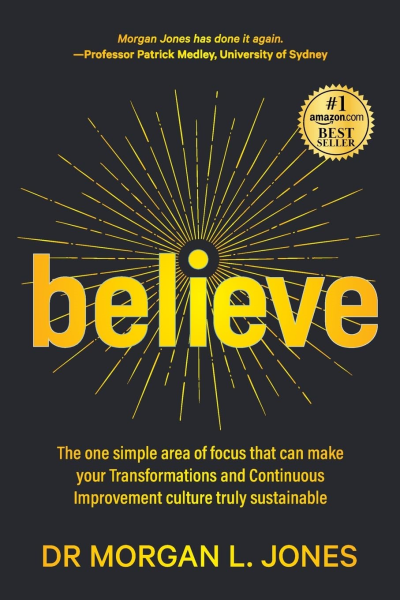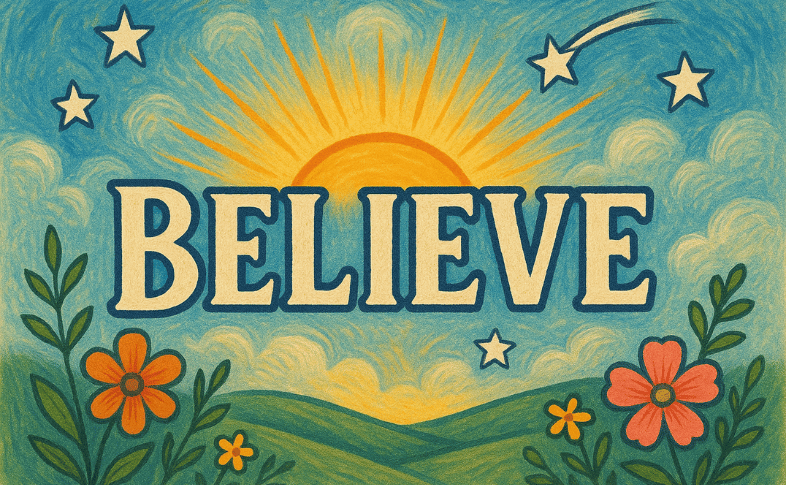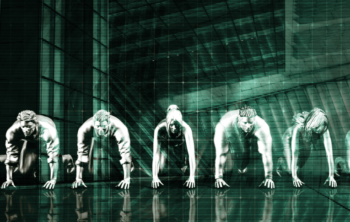Reaching for business transformation and continuous improvement success may feel like chasing a mirage — appearing promising at first, only to fade away as resistance sets in and priorities shift. But what if there was one simple area of focus that could make your transformation efforts not only sustainable, but deeply embedded in the culture of your organization?
Dr. Morgan L. Jones, author of Believe and global expert in operational excellence, argues that the secret lies in aligning belief, behavior, and systems. At Way We Do, we build platforms that enable companies to create, document, and activate their management systems — but the software is only as effective as the belief behind it. Without alignment at the team level, systems fall flat.

The Power of Belief
Dr. Jones emphasizes that real team alignment doesn’t start with strategy decks or corporate slogans — it begins in the heart. Quoting leadership examples from sport and military, he explains that when people believe in something greater than themselves, they are inspired to act consistently, even when no one is watching.
Take the New Zealand All Blacks, whose culture centers around humility, legacy, and team before self. Players clean their own locker rooms, reinforcing that the jersey is more important than the individual. That belief drives world-class behavior.
Similarly, your employees won’t follow procedures simply because they’re documented — they’ll follow them because they believe in the purpose behind them. Whether it’s safety, quality, or customer experience, belief is the engine that drives sustainable behavior.
Inner and Outer Team Alignment
Dr. Jones introduces a concept he calls the “inner and outer wheel”:
-
Outer wheel: What people say and do — the observable behaviors.
-
Inner wheel: What people think and believe — the internal truths that drive behavior.
We often focus on the outer — what we can measure, record, and report. But unless behavior is backed by true belief, the system breaks. You may have policies and procedures activated in platforms like Way We Do, but unless the team genuinely believes in their value, they won’t stick.
Misalignment isn’t subtle — your team will notice it instantly. As Dr. Jones humorously puts it, “The space between your ears is the best BS detector you have.” Teams instinctively sense when leadership says one thing and does another.
What Drives Belief?
So how do we build belief?
-
Felt experience: One of Dr. Jones’ most powerful insights is that belief is shaped by lived experience. If someone submits three great improvement ideas and all are dismissed, their belief in the system collapses — no matter how many posters about innovation are on the wall.
-
Emotional connection: Belief is emotional, not intellectual. It’s why leaders must learn to communicate with empathy, using language that builds trust. As Jones notes, “I want people to want to do things — not because they have to, but because they believe it’s the right thing to do.”
-
Reinforcement: Positive reinforcement — particularly peer-to-peer recognition — is critical. And it needs to be consistent. Research shows it takes 6–7 positive interactions to neutralize a single negative one.
Systems Reinforce Belief (Or Undermine It)
This is where platforms like Way We Do play a vital role. Systems and tools shape the environment in which people work. If your workflow system makes it easy to log issues, share improvements, and feel seen for contributing, then it reinforces the belief that “my ideas matter.”
But if your systems are clunky, misaligned, or focused solely on compliance for compliance’s sake, they can do the opposite. They can send the message that procedures are red tape — not enablers of better outcomes.
Way We Do helps organizations activate their documented policies, procedures, and training materials into workflows. But to truly unlock that value, leaders must ask:
-
Do these systems support the behaviors we want to see?
-
Do they make it easier for our people to do the right thing?
-
Do they reflect our values in action?
If not, no amount of software will deliver cultural transformation.
The Samoan Safety Vest Story: From Mandate to Meaning
One of the most memorable stories from Dr. Jones’ talk highlights just how powerful belief can be when it’s connected to meaning.
A large company operating in the Pacific Islands was struggling with a safety compliance issue: Samoan workers were refusing to wear their high-visibility vests. Despite the procedure being mandated from head office in Sydney, compliance remained low. Jones was sent in to “fix the problem.”
Rather than enforcing the rule with authority, he did something different. He listened.
He spoke not only with workers and supervisors but also with community leaders and the powerful aunties — women in Samoan culture who hold deep influence over family and community behavior. He learned that the workers were motivated by providing for their families and supporting their villages. That was the underlying belief driving their behavior — not defiance, but pride and responsibility.
So instead of enforcing a rule, they reframed it with meaning. Workers were given high-vis shirts with a clear pocket over the chest, and inside that pocket was placed a photo of their family. The message became: “I wear this to go home safely to them.”
Within 24 hours, they achieved 100% compliance.
That’s the power of belief. Not because someone said “you must,” but because they felt “I want to.”
Leadership and Language
Leadership sets the tone. And language matters.
Dr. Jones recalls his Navy experience, where an admiral told him, “Your crew will follow you anywhere — just make sure they go where I want them to go.” In other words, belief in the leader drives action, but team alignment ensures it’s headed in the right direction.
He points to David Marquet’s work in Turn the Ship Around, which shows that shifting from “command and control” to “intent-based leadership” transforms team ownership. Instead of saying “Do this,” leaders ask, “What did you consider when you made that decision?” This shift encourages reflection and engagement.
Customers as Your Leadership Mirror
Dr. Jones challenges leaders to view their team members as internal customers — recipients of a “leadership service.” This means asking:
-
How do I want my people to feel after interacting with me?
-
What do I need to say or do to inspire belief in our purpose?
-
Are the systems and rituals (e.g., daily huddles, standups, check-ins) reinforcing or eroding that belief?
If you’re not asking these questions, you may be unknowingly contributing to misalignment.
Make It Real
Ultimately, what makes transformation sustainable isn’t just systems — it’s belief and systems working together.
Here’s a simple framework to reflect on with your leadership team:
-
Start with the “why” – Why does this change matter to our people? What belief are we trying to inspire?
-
Define the behaviors – What does team alignment look like in action?
-
Check your systems – Are our processes within Way We Do reinforcing or undermining those behaviors?
-
Create artifacts – Recognition, rituals, storytelling, and feedback loops that cement belief.
-
Lead with authenticity – Your actions must match your words — because your people are always watching.
As Dr. Jones reminds us, “belief precedes achievement”
You can’t systematize your way out of a disengaged culture. But if you create systems that reinforce belief — and if your leadership behaviors consistently reflect your values — then continuous improvement isn’t just possible. It becomes inevitable.
So, as you reflect on your own organization’s journey, ask yourself: “Do our systems inspire belief? Do our leaders align with our values? And do our people feel that they are part of something meaningful?”
If not, it’s time to align your team with belief, behavior, and systems.
When you purchase the book Believe, all proceeds are donated to Dementia Australia.





